São Tomé is the capital of São Tomé and Príncipe. The city is known for its colonial architecture, bustling markets, and scenic ocean views.
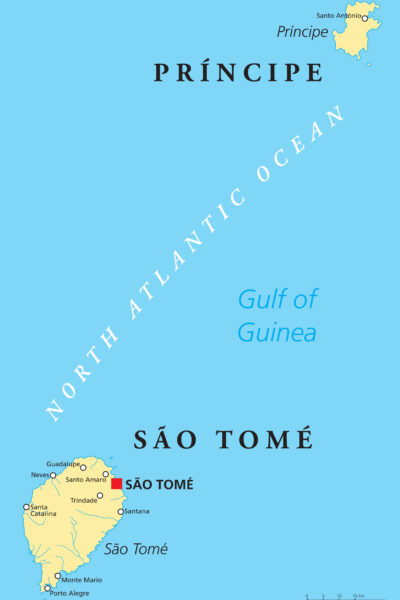
São Tomé serves as the country’s political and economic center and plays a crucial role in the nation’s cocoa and coffee industries. Adding to its allure are the lush natural surroundings, including nearby beaches and forested areas offering relaxation and outdoor adventures.
Where is São Tomé?
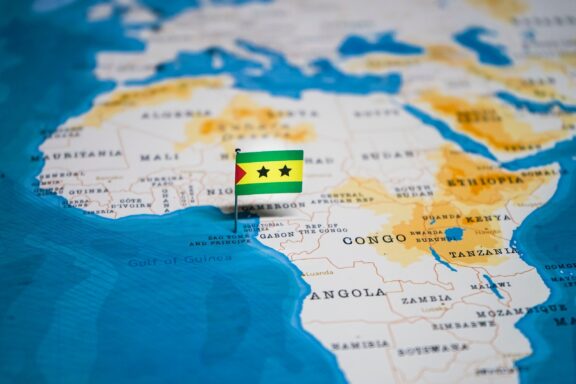
The capital city is found on the northeastern shoreline of São Tomé island, the larger of two principal landmasses constituting São Tomé and Príncipe. This island nation nestles in the Gulf of Guinea, just off Central Africa’s western edge.
Located near the equator, the capital has geographic coordinates of 0.3367 °N latitude and 6.7270 °E longitude. It is about 250 kilometers away from the border of Gabon on the African continent.
History of São Tomé
After its founding by Portuguese explorers, the city rapidly gained prominence as a critical outpost for the Portuguese Crown. Initially, the area around the city was exploited for its natural resources, and soon after, sugar cane plantations were established.
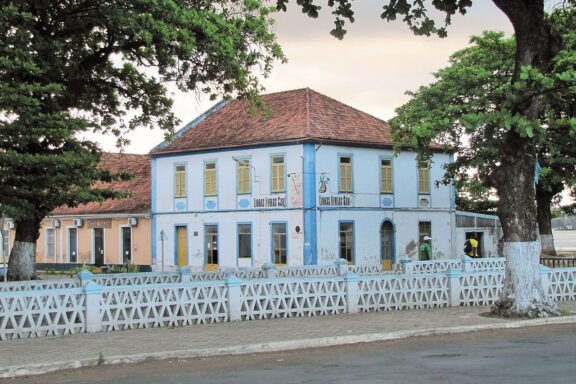
The colony’s governance was primarily centralized in the city, making it a hub for colonial administration and a locus of European influence.
During this period, the city was intricately linked to the trans-Atlantic slave trade. Ships carrying enslaved Africans would often dock at its port before making their way to the Americas. The labor force was primarily used in plantations surrounding the city.
This phase in the city’s history also saw an influx of enslaved and free Africans and mixed-race individuals who contributed to the city’s multicultural fabric.
As the global sentiment against slavery grew, the city transitioned from a slave-based economy to one relying on contract labor. Cocoa became the dominant export, replacing sugar cane and boosting the local economy.
Infrastructure began to improve, and the city resembled a more modern colonial capital, complete with administrative buildings and increased European settlement.
When São Tomé and Príncipe gained independence on July 12, 1975, the city transitioned from a colonial outpost to a sovereign nation’s political and administrative center.
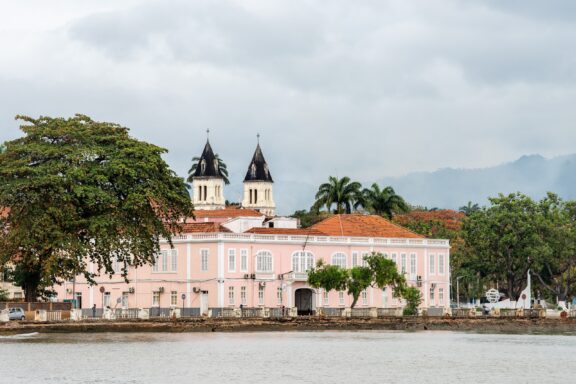
The transition was fraught with challenges, including political instability and economic hardships, but it also brought opportunities for governance reforms and infrastructural development. The city became home to the nation’s primary institutions, including the presidency and the legislative assembly.
The city has recently continued to evolve, seeking to balance its prosperous past with the needs of a growing population and economy. Landmarks that bear witness to its history coexist with modern buildings and facilities.
The city has also become more cosmopolitan, with a growing expatriate community and increasing tourism, adding another layer to its complex identity.
Features of São Tomé
São Tomé exudes a captivating mixture of historical and contemporary. Colonial structures silently witness a history shaped by Portuguese influence and agricultural expansion that contrast with modern offices that have sprung up in recent years, symbolizing the city’s ongoing transformation.
The city’s markets are buzzing hubs of activity, offering everything from fresh produce to locally crafted goods, capturing the essence of its diverse and resourceful community. The central square, often used for public gatherings and celebrations, exemplifies the city’s role as the political and social heart of the nation.
Geography and Climate
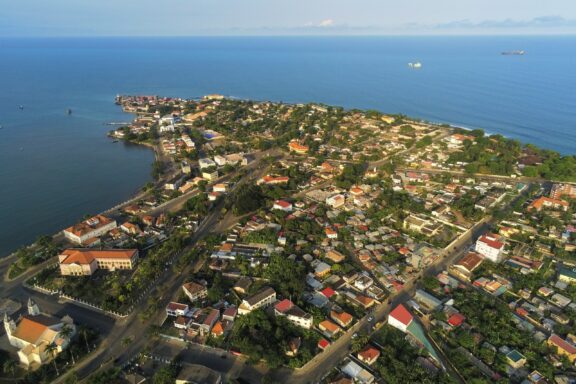
Surrounded by lush forests and situated near the coastline, the capital city offers a mix of tropical landscapes and maritime beauty. While I previously mentioned its location, it’s worth noting that the city’s geography contributes to its climate.
The climate is tropical, with a wet season from October to May and a dry season from June to September. Average temperatures range from 24 °C to 30 °C (75 °F to 86 °F), making it warm throughout the year. Rainfall is abundant during the wet season, contributing to the area’s rich biodiversity.
Population
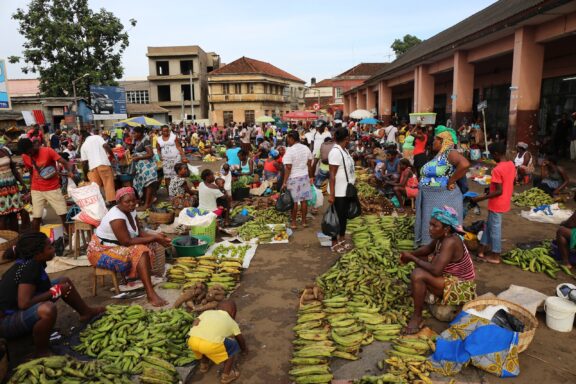
The city is a melting pot of cultures and ethnicities. While most of the population is of African descent, there is also a notable presence of people of mixed African and Portuguese ancestry and a smaller community of expatriates.
The official language is Portuguese, but many locals also speak Forro, a Creole language. Religion plays a significant role in the community, with Christianity being the dominant faith.
The city is also a hub for education and healthcare, hosting various schools and medical facilities that serve the local population and people from the surrounding regions.
Economy
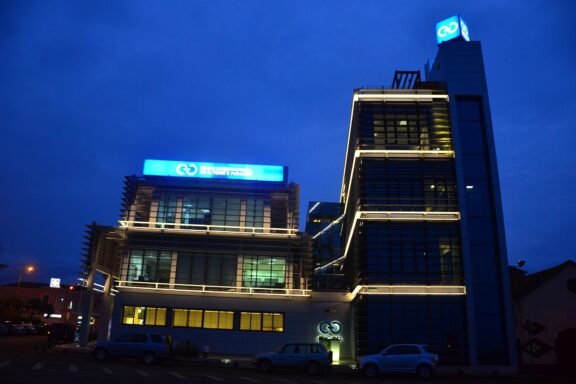
The capital city’s economy is diverse and serves as the economic engine for the entire country. While it’s known for its role in the nation’s cocoa and coffee trade, it also has a growing service sector, including tourism, finance, and administration.
The presence of government institutions has also led to the proliferation of jobs in the public sector. Small-scale fishing and local handicrafts add another dimension to the city’s economic landscape.
Despite its many activities, the city faces challenges such as unemployment and underdevelopment, which are subjects of ongoing policy discussions and reforms.
Things to Do and Places to See in São Tomé
There is a diverse array of fun things to do and see in São Tomé. Let’s take a look at some of the most popular sites and attractions in São Tomé:
1. National Museum, Fort São Sebastião
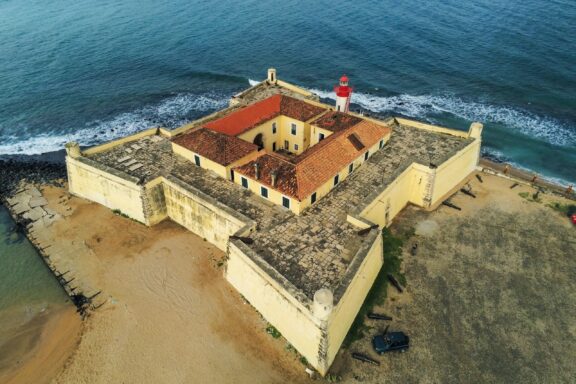
Fort São Sebastião stands as a monumental vestige of São Tomé’s turbulent past. Located near the island’s northern tip, the fort is an intriguing site for anyone keen on understanding the maritime and defense strategies of the 16th century.
The fort offers a multi-faceted experience. Visitors can explore the museum’s collections alongside a self-guided or guided tour through its intriguing architecture. The spot also offers stunning ocean views, adding a scenic backdrop to the historical visit.
2. Cathedral of São Tomé
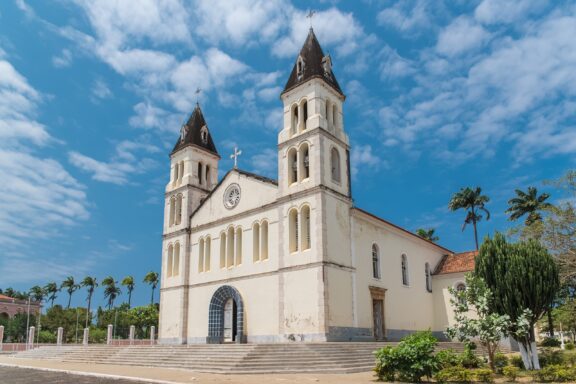
The Cathedral of São Tomé is a cornerstone of spiritual life on the island. Often overlooked in favor of the island’s natural attractions, the Cathedral has a quiet charm that captures the essence of the island’s religious influences.
Guests can attend services, participate in community events, or quietly roam the peaceful interiors. The Cathedral’s proximity to local markets also offers an easy segue into daily island life.
3. Lagarto Beach
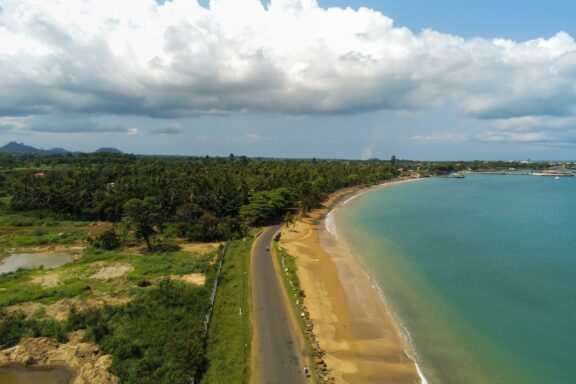
Lagarto Beach is a natural haven that showcases São Tomé’s untouched beauty. Situated along the coast, it is a popular spot for locals and tourists looking to unwind. The beach features golden sands, crystalline waters, and lush tropical greenery surrounding the area.
Unlike commercialized tourist destinations, Lagarto Beach maintains a tranquil, unspoiled ambiance where visitors can swim, sunbathe, or picnic.
The beach is also a starting point for some nature trails, adding a touch of adventure for those looking to explore beyond the coast.
4. Casa da Cultura de São Tomé
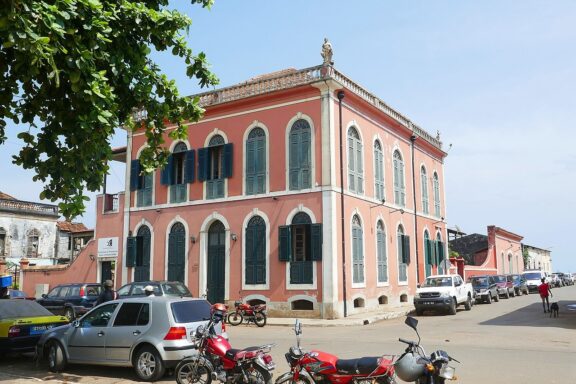
The Casa da Cultura is a hub for the arts and humanities, serving as a focal point for cultural exchange and artistic expression in São Tomé. Housed in a colonial-era building, the center features galleries, exhibition spaces, and even a small theater.
The Casa da Cultura offers a constantly changing lineup of cultural activities, ranging from art exhibitions to talks. Visitors can participate in interactive workshops, explore modern art displays, or attend live shows.
5. Roca Agua Izé Open Air Museum
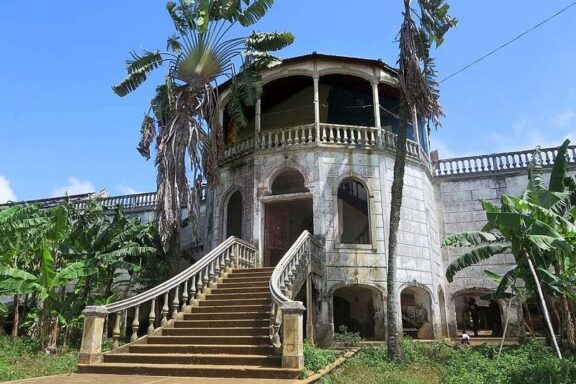
Roca Agua Izé is a window into São Tomé’s colonial and agrarian past. Once a thriving cocoa plantation, it offers a rich educational experience encapsulating the socio-economic evolution of the island.
The site is dotted with plantation buildings, workers’ quarters, and the remnants of cocoa processing facilities. These structures, overgrown by tropical flora, create an atmospheric setting that feels almost frozen in time.
6. Old Seat of Banco Internacional de São Tomé e Príncipe
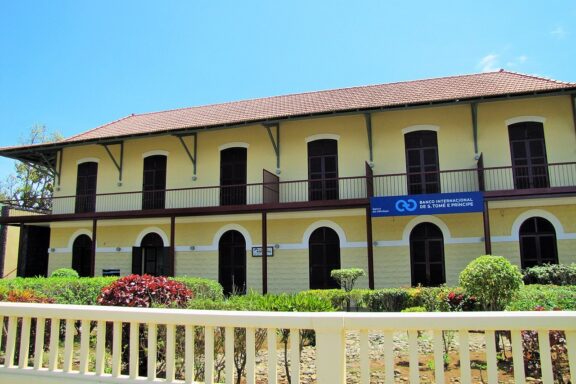
The Old Seat of Banco Internacional offers a unique blend of architectural splendor and financial history. As a standing testimony to the island’s evolving economy, the building now serves as an intriguing tourist site.
Those who visit can explore the architecture, take photographs, and learn about the financial history of São Tomé through any exhibitions or information boards that might be available.
7. Ana Chaves Bay
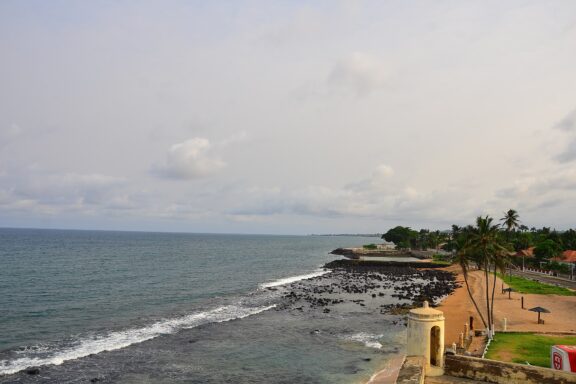
Named after a notable Portuguese trader, Ana Chaves Bay is more than just a picturesque locale; it’s a maritime landmark that has influenced the island’s development for centuries. The bay is enveloped by verdant hills and sparkling waters, offering an ideal setting for various water activities.
Numerous functional and recreational boats can often be seen dotting the waters. Here, you can take boat tours, try fishing, or enjoy the bay’s natural beauty. The area is also rich in seafood restaurants, providing a gastronomic accompaniment to the scenic views.
8. Explore Downtown São Tomé City
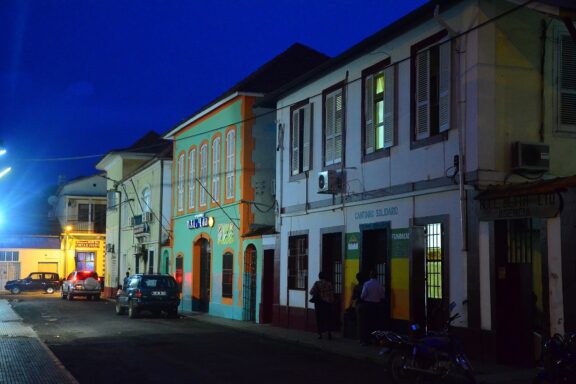
Downtown São Tomé City is a bustling and lively area that captures the essence of daily life on the island while offering a potpourri of experiences for visitors. The downtown area features a mix of commercial and residential buildings interspersed with cafes, shops, and public squares.
Street art, local vendors, and the occasional live performance add vibrancy to the cityscape. The area is walkable, allowing for easy exploration, and serves as a launch point for various city tours.
Frequently Asked Questions
What is the best time to visit São Tomé?
The best time to visit São Tomé is during the dry season from June to September, when the weather is pleasant and outdoor activities are more enjoyable.
What is traditional food São Tomé like?
The traditional cuisine in the capital city is a fusion of African, Portuguese, and even some Brazilian influences, reflecting its colonial past and multicultural makeup.
Seafood is abundant, thanks to its proximity to the ocean, while tropical fruits and root vegetables are also integral to the diet. Spices like chili and garlic often flavor dishes influenced by Portuguese culinary traditions.
What is a must-try dish in?
When visiting, several dishes provide an authentic taste of local cuisine. Here are the top 4 must-try dishes:
1. Calulu: A flavorful fish stew made with palm oil, okra, and vegetables.
2. Feijoada: A hearty bean stew often made with pork, vegetables, and spices.
3. Santomean Fish Soup: A seafood-based soup often enriched with coconut milk.
4. Fruta Pão Frita: Fried breadfruit slices, usually served as a side dish or snack.
How safe is São Tomé for tourists?
São Tomé is generally a very safe place for travelers. Violent crimes such as armed robberies are rare. However, caution is advised when driving due to large potholes, especially on roads outside the city, which can be impassable during the rainy season.
What currency is used in São Tomé, and where can I exchange money?
The currency used in São Tomé is the São Tomé and Príncipe dobra. Money can be exchanged at banks, hotels, or authorized exchange offices.
How do I get around in São Tomé?
Are there public transportation options?
Public transportation options in São Tomé include buses and shared taxis. Rental cars are also available.
Final Thoughts
São Tomé, despite being a small city in one of the smallest countries in the world, provides a diverse range of experiences, from exploring local markets to strolling along scenic waterfronts. While it may lack the grandiosity of larger, more developed cities, its charm lies in its simplicity and the warmth of its people.
It’s a place where you can experience a different pace of life and gain insights into the culture and history of this captivating island nation. Overall, São Tomé is undoubtedly worth a visit for those looking to explore a less-traveled yet enriching destination.
Image Sources and Copyright Information
- Map of São Tomé and Príncipe: © Peter Hermes Furian/Shutterstock
- Flag Pin on São Tomé and Príncipe Map: © hyotographics/Shutterstock
- Colonial Houses in São Tomé: © Chuck Moravec/Wikimedia | CC BY 2.0 Generic
- Presidential Palace of São Tomé by the Waterfront: © mbrand85/Shutterstock
- Aerial View of Coastal Cityscape: © Xinovap/Shutterstock
- Bustling Outdoor Market Scene: © BOULENGER Xavier/Shutterstock
- Modern Bank Building at Twilight: © Ben Sutherland/Wikimedia | CC BY 2.0 Generic
- Aerial View of Fort Sao Sebastiao on Coastline: © Xinovap/Shutterstock
- Cathedral Under Blue Sky: © Pascale Gueret/Shutterstock
- Tropical Beach Road Aerial View: © Xinovap/Shutterstock
- Colonial Style Building in Urban Setting: © Ji-Elle/Wikimedia | CC BY-SA 4.0 International
- Unfinished Tropical Mansion with Staircase: © David Stanley/Flickr
- Colonial Style Building with Banco Internacional Signage: © Chuck Moravec/Wikimedia | CC BY 2.0 Generic
- Coastal View of Ana Chaves Bay: © Ben Sutherland/Wikimedia | CC BY 2.0 Generic
- Downtown São Tomé at Night: © Ben Sutherland/Wikimedia | CC BY 2.0 Generic